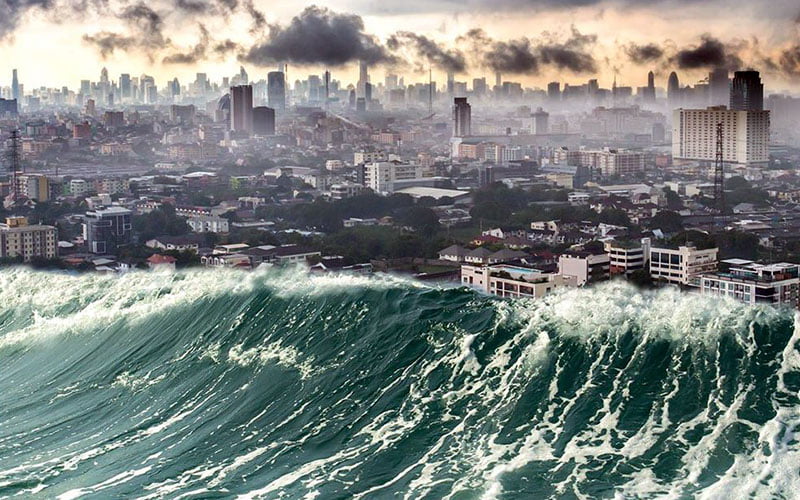
Tsunamis are awe-inspiring natural phenomena that have the potential to cause immense destruction and loss of life. These massive ocean waves, often referred to as tidal waves, can devastate coastal areas with their tremendous force. But how do tsunamis form? In this comprehensive guide, we will delve into the intricate processes and factors that contribute to the formation of tsunamis. From their origins to their devastating consequences, we will explore every aspect of these powerful waves.
Tsunamis primarily form as a result of underwater disturbances, such as earthquakes, volcanic eruptions, or landslides. The most common trigger is an undersea earthquake, which occurs when tectonic plates beneath the ocean floor shift and release immense amounts of energy. When this energy is suddenly unleashed, it displaces a significant volume of water, generating powerful waves that propagate outward from the source.
Subduction zones, where one tectonic plate is forced beneath another, are particularly prone to generating tsunamis. These zones, often found around the Pacific Ocean in what is known as the “Ring of Fire,” experience frequent seismic activity. When a powerful earthquake strikes in a subduction zone, it can uplift or displace the seafloor, resulting in the formation of a tsunami.
Volcanic eruptions, especially those occurring near coastlines, can also give rise to tsunamis. When a volcano erupts underwater, it can cause a sudden displacement of water, generating a series of powerful waves. These volcanic tsunamis can be particularly devastating due to their proximity to populated coastal areas.
In addition to earthquakes and volcanic eruptions, large landslides that occur near bodies of water can trigger tsunamis. When a significant amount of material, such as rocks, soil, or ice, rapidly slides into a lake or ocean, it displaces a substantial volume of water, leading to the formation of tsunami waves. These landslide-induced tsunamis can occur with little to no warning, posing a significant threat to coastal communities.
While the initial trigger event plays a crucial role in the formation of a tsunami, several factors influence its magnitude and potential impact. Understanding these factors is essential in developing effective warning systems and preparedness strategies.
The magnitude of the underwater disturbance, such as the earthquake’s magnitude or the scale of a volcanic eruption, directly affects the size and strength of the resulting tsunami. Larger disturbances release more energy and displace more water, leading to more substantial and more destructive waves.
The distance between the source of the tsunami and the affected coastline is another critical factor in determining the wave’s magnitude. As the tsunami travels across the ocean, it gradually loses energy. Therefore, areas closer to the source are likely to experience more significant wave heights than those farther away.
The shape and slope of the coastline also play a role in the impact of a tsunami. Coastal areas with shallow, gradually sloping seabeds tend to experience more significant inundation and flooding when a tsunami reaches the shore. In contrast, steep cliffs or deep ocean trenches can partially dissipate the wave’s energy, reducing its destructive potential.
A: It can take anywhere from a few minutes to several hours for a tsunami to form after the triggering event occurs. The time depends on various factors, such as the distance from the source, the magnitude of the disturbance, and the speed at which the waves propagate.
A: While it is challenging to predict the exact timing of a tsunami, scientists and researchers have made significant advancements in tsunami warning systems. By monitoring seismic activity and ocean conditions, experts can provide timely warnings and evacuate vulnerable coastal areas.
A: Yes, tsunamis can occur in lakes, although they are relatively rare compared to those in the ocean. Large landslides or volcanic eruptions near lakes can trigger tsunamis by displacing a significant volume of water.
A: No, the destructive potential of a tsunami depends on various factors, such as the magnitude of the triggering event, the distance from the source, and the coastal topography. Some tsunamis may produce relatively minor waves, while others can cause widespread devastation.
A: It is not currently possible to stop or prevent a tsunami once it has been generated. However, early warning systems, effective evacuation plans, and public awareness can significantly reduce the loss of life and property damage caused by tsunamis.
A: Tsunamis are more prevalent in certain regions, particularly in the Pacific Ocean’s “Ring of Fire.” This area is characterized by intense tectonic activity, including subduction zones and volcanic eruptions, making it more prone to tsunamis. However, tsunamis can occur in any ocean or sea where the necessary triggering events take place.
In conclusion, tsunamis are natural disasters that result from underwater disturbances such as earthquakes, volcanic eruptions, or landslides. Understanding how tsunamis form and the factors that influence their magnitude is crucial for coastal communities’ preparedness and safety. With advanced warning systems and effective disaster management strategies, we can minimize the devastating impacts of these powerful waves.
Recommended other topics: Earth Spinning Faster-Exploring the Phenomenon










© InfoDoot. All Rights Reserved.